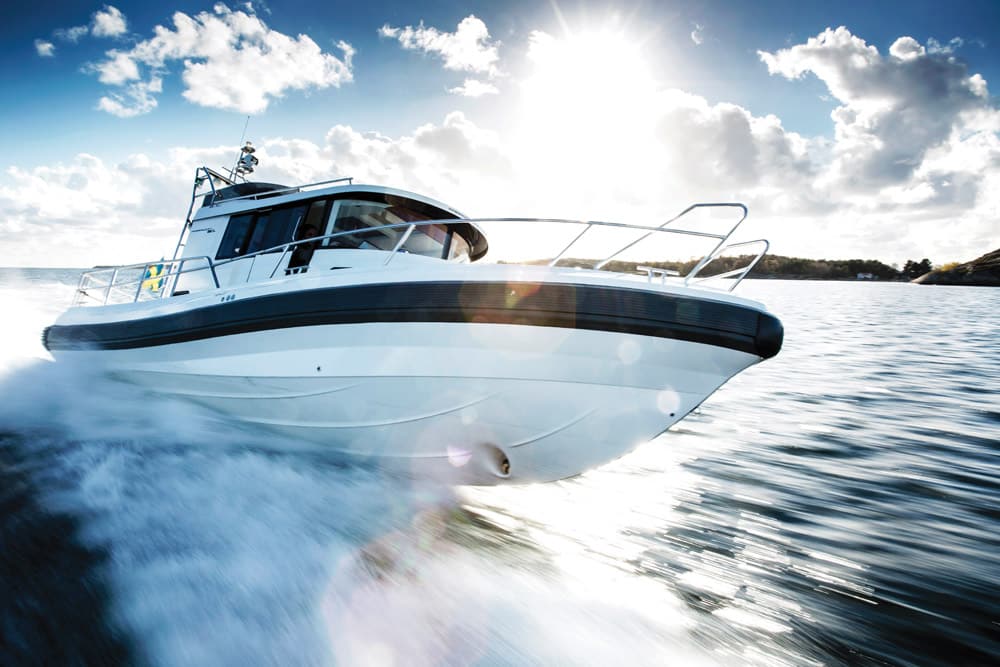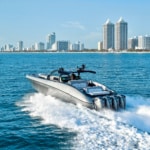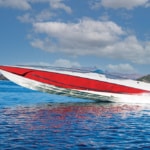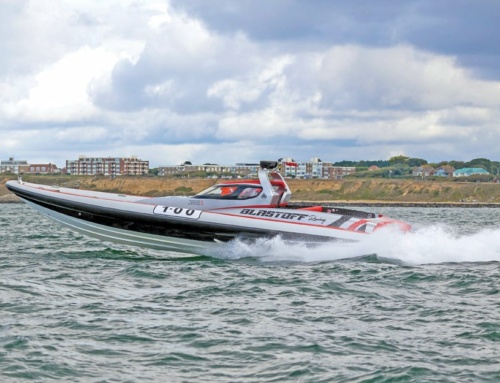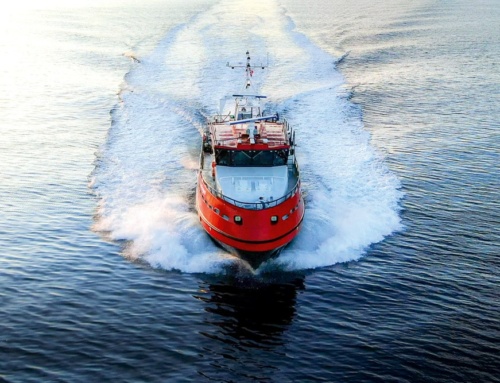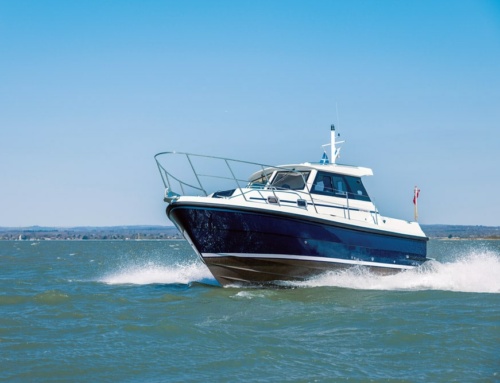Many of us with a keen interest in powerboat design are also attracted to the exhilarating experience of high-speed boat driving. Your boat might be capable of going faster than your skills can safely guide it, so here are some tips to consider if you’re intending to push your rig to the limit!
Getting safe for going fast
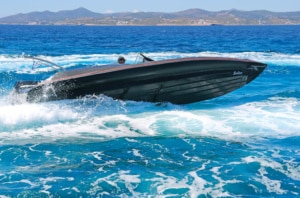
Multiple chines for lateral grip on the Tropida Saita RIB
My racing experiences have taught me that knowing you have a safe and secure hull set-up can actually help you drive confidently at high speed. Buckle your life jacket and always connect your kill cord. Rig your boat with solid engine mounts and secure steering systems. Use wheel-mounted trim switches and a foot throttle for the best ‘hands-on’ driving control.
TIP 1 Safe steering
Secure steering without slack is a necessity for good control and reduced boat wobble – especially on vee-bottom hulls. Mechanical steering systems provide good driving ‘feedback’ but can develop backlash or ‘sloppiness’. Dual (twin) cable steering allows for adjustment to remove backlash, engine flutter and the resulting handling instability. Hydraulic steering provides a more direct control and better driving comfort but doesn’t offer as much torque feedback.
TIP 2 Weight distribution
When driving at high speeds, the balance of weight in your hull can improve stability. If fuel load, fish wells, batteries, etc. are not equalised from side to side, your boat can be out of balance. If your boat is set up for side-by-side passenger seating, when you’re out alone there is a potential lateral imbalance that can cause unsafe handling when turning or in cross waves. Adding weight to the passenger side can help this situation by equalising weight distribution.
TIP 3 ‘Seat time’ – get to know your boat
Perhaps this sounds obvious, but as you’re learning to drive your boat at high speeds, you should ‘take it slow’ at first. The best learning experience is to get ‘seat time’ at relatively low speeds in smaller boats, progressing to higher speeds and bigger boats. There’s a lot going on when driving a boat at high speed, and newcomers may experience sensory overload that can reduce reaction times. If you’re buying your first go-fast boat, get some instruction from a proficient operator first, preferably in your own boat.
TIP 4 Get planing
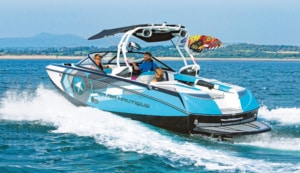
A quick planing American ski boat hull.
We can’t get to any fast speeds until we get the boat planing. Often getting up on the plane can take some practice. This phase can be different depending on weight load and water conditions.
TIP 5 Propeller Slip
Getting the propeller to ‘bite’, without too much slip or cavitation, is best accomplished by starting with only a little trim – sometimes negative trim – to help control the boat’s tendency for ‘bow-up’ attitude. As more throttle is applied, the boat will naturally come onto the plane and flatten its attitude. Sometimes, particularly with vee-pad hulls, the boat can lean to one (usually port) side as it settles on the plane. Slightly more positive trim can change the propeller thrust angle, reduce gearcase drag and the boat will straighten itself out. At slower and mid-range speeds, lower trim settings will result in a smoother ride and better fuel efficiency.
TIP 6 Engine height
If your rig has a power jack plate, it can be helpful to lower the engine height when low- or mid-speed cruising. This setting can lead to more efficient performance, better fuel economy and a smoother ride.
TIP 7 Porpoising
A ‘bouncing’ or porpoising motion can often occur at a velocity where the hull dynamic lift and drag forces are changing – such as just after achieving planing or when a vee-pad hull transitions to the pad-lift stage. If a boat is porpoising at a given speed and load, lowering the trim angle will reduce or eliminate the porpoising.
- When it comes to ‘muscle boats’, the Americans lead the way
- The sure-footed Agapi RIB
- A race derived stepped hull well trimmed out
(You can read more about ‘Porpoising’ in the October 2020 issue of PBR.)
Driving tips for going fast
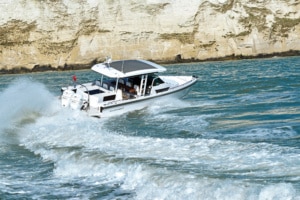
Axopar 37 Sun Top. The Scandinavians are renowned for their purposeful sports craft
Vee hulls at high speed are balanced on a small, narrow, aftward section of hull. Vee-pad hulls require balancing on a small section of the centre pad. On both hull styles, seat time is the secret to going fast.
When getting used to a new rig, adding weight can be helpful to your ‘learning curve’. With a little extra weight in the bow, the boat will be slower and less responsive to trim and power, so it’s easier to drive. As you get more comfortable with your boat’s personality, remove a little weight, practise and learn the difference in behaviour of the lighter rig.
Once you’re comfortable with your boat’s behaviour at speed, apply more throttle and more trim. Increase your throttle only when the boat is steady and level. To pick up more speed, trim out the drive(s) a little at a time so that the boat is still riding level and cleanly across waves.
When trying to balance the boat at high speed, it can help to tilt the steering wheel with slight pressure against the engine/propeller torque – this can help steady the boat from side-to-side instabilities and can often prevent pad-walking. (You can read more about ‘Chine Walk’ in the March/April 2020 issue of PBR.)
TIP 11 Making turns
Turning can be tricky. In most hulls, it’s best to reduce throttle and/or trim down slightly prior to starting a turn (except with stepped hulls). You can increase throttle and trim as you power through the turn.
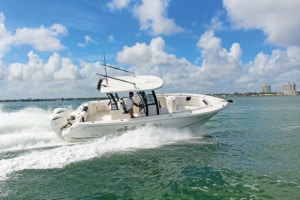
The sporty handling Robalo showing her paces
TIP 12 Stepped hulls
Vee hulls with stepped bottoms can add driving complexity. Steps can present a ‘trip edge’ during some manoeuvres that change the bottom loading. Trimming down before entering a turn in a stepped hull can cause a sudden instability – even rollover in some hulls. It’s important to get instruction from your stepped-hull supplier about trimming during turning manoeuvres. Better still, hands-on instruction from an expert with experience driving your hull design is valuable. Every hull is different in turns, so don’t assume that the procedure that works well with one hull will translate predictably to a different boat.
More trim = more speed
In general, adding more (up) trim will reduce gearcase drag and hull wetted surface and increase velocity. High trim angles will also, ultimately, increase hull dynamic instability. There’s a point of ‘too much trim’ where the hull will not react favourably to small perturbations such as wind, water, obstacles, etc. That last 1mph is best left on the table by resisting the temptation of ‘more trim’.
Rough conditions
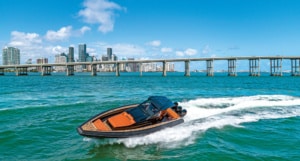
Technohull Omega 47 – one of the finest hulls in the RIB sector
It is much easier to drive your fast boat in perfect conditions, balancing on a few inches of vee surface, centre pad or sponsons. The best way to become familiar with your boat’s handling characteristics in heavy waves or severe crosswinds is with more ‘seat time’.
When your boat is at high speed, an instinctive reaction to a potential problem like traffic, waves or wind gust is to back off the throttle. This can be a mistake, however, triggering violent hull instability that could result in hooking, rolling, stuffing or even blowing over backwards. An appropriate corrective action is usually to ‘trim down’ a little and ease back the throttle slightly. This will dampen any aggressive hull reaction and give you the opportunity to drive through your obstacle. If you’re paying close attention to what’s going on around you, the need for drastic avoidance manoeuvres should be minimised.
If conditions are poor, such as heavy waves, rollers or crosswinds, it’s best to cruise with reduced engine trim and a lower jack plate (engine height).
Cross waves are the trickiest, especially in a vee-bottom hull; it’s best to approach cross waves with bow on at an angle (30 degrees). Avoid any abrupt throttle, trim or steering manoeuvres if possible.
Tricky situations
Learn how your boat reacts to sudden driver inputs. In a safe section of water, free of traffic, practise at slow speeds and low trim angles, working your way up to faster speeds and higher trim angles. Test steering response to a short, controlled wheel turn to one side and back to neutral, noting how your boat responds. Your boat might turn hard or roll heavily, but it will calm down just as quickly. After successfully practising this manoeuvre, try it again at higher speeds, then at higher trim angles. The boat’s reactions will be less friendly. Using steering and (down) trim together to settle the boat will eventually become a second-nature reaction.
Go-fast safety tips
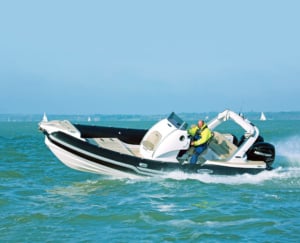
The Stingher 800 GT’s beamy deep-vee predictability.
Powerboats don’t have brakes, so drivers need to be aware of their speed and the time needed to react to safely avoid difficult situations. At 60mph your boat is covering 88 feet every second. If a change in performance or conditions presents itself, there’s not much time to react, so pay attention.
Water can go from calm to rough, and winds can change in seconds. The pilot should not attempt to drive his boat faster than the conditions allow – and must anticipate what the conditions could be in the next few seconds.
The bottom line
It takes a lot of practice and ‘seat time’, but practising driving skills can ultimately save your life or injury when you really need to make manoeuvres to avoid hitting something without losing control. You might still get into trouble, but your experience and practice will make you familiar with your boat’s reactions to sudden changes in direction, and you can have the confidence to respond in the safest way when under pressure.
Keep safe and always wear your kill cord!

